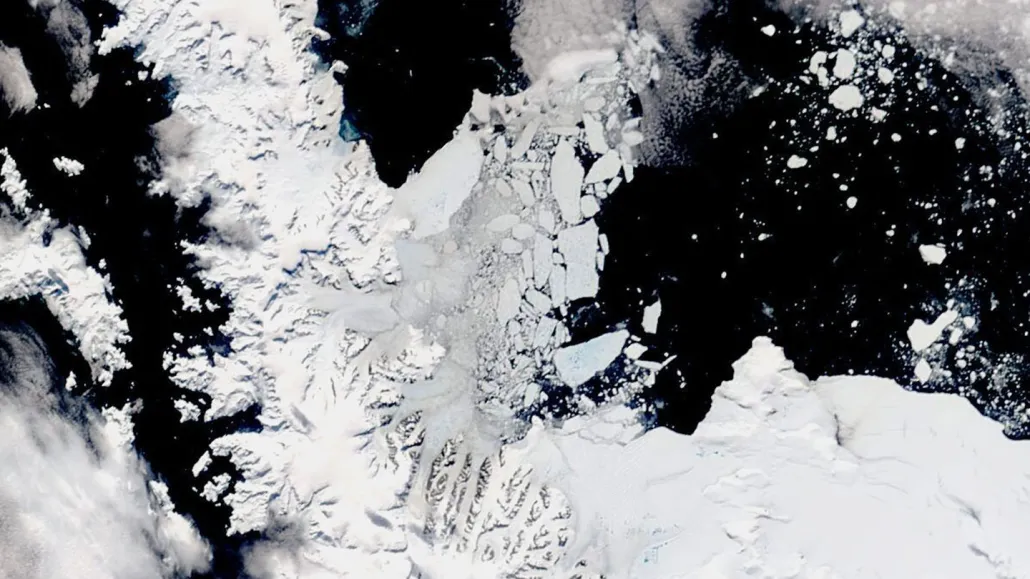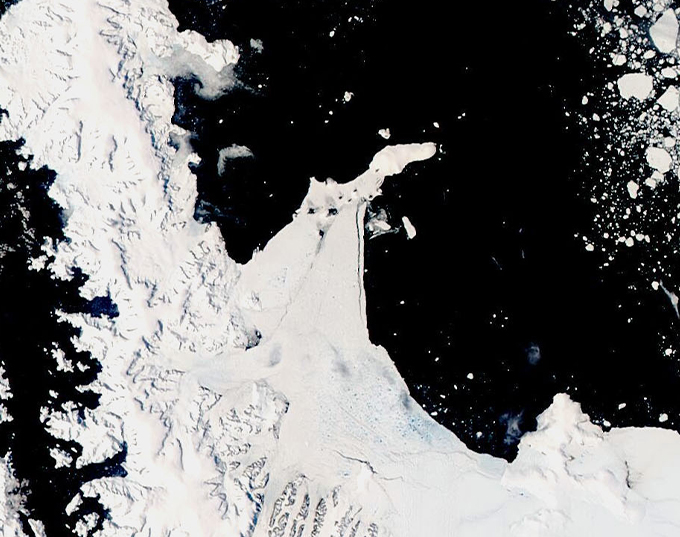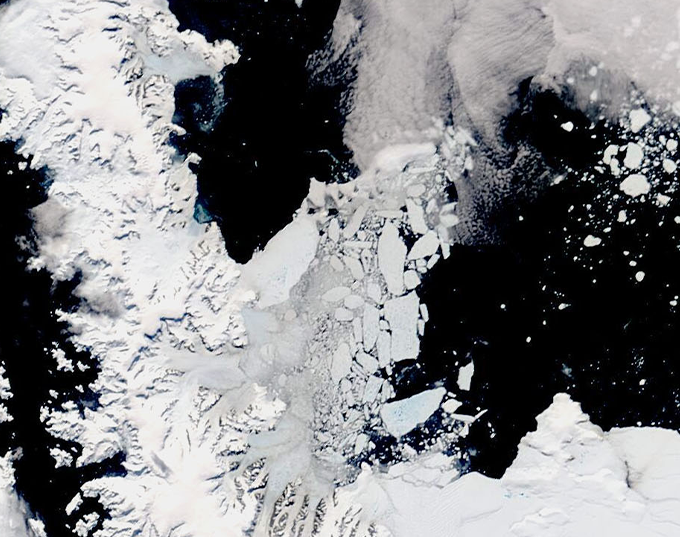
The breakup of sea ice along the Antarctic Peninsula (seen in this satellite photo) in 2022 has led to the rapid retreat of three glaciers that flow into the bay.
Joshua Stevens, MODIS/LANCE/EOSDIS/NASA, WORLDVIEW/GIBS/NASA
By Douglas Fox
- More than 2 years ago
Read another version of this article at Science News Explores
SAN FRANCISCO — Several Antarctic glaciers are undergoing dramatic acceleration and ice loss. Hektoria Glacier, the worst affected, has quadrupled its sliding speed and lost 25 kilometers of ice off its front in just 16 months, scientists say.
The rapid retreat “is really unheard of,” says Mathieu Morlighem, a glaciologist at Dartmouth College who was not part of the team reporting these findings.
The collapse was triggered by unusually warm ocean temperatures, which caused sea ice to retreat. This allowed a series of large waves to hit a section of coastline that is normally shielded from them. “What we’re seeing here is an indication of what could happen elsewhere” in Antarctica, says Naomi Ochwat, a glaciologist at the University of Colorado Boulder who presented the findings December 11 at the American Geophysical Union meeting.
Hektoria Glacier, Green Glacier, and Crane Glacier sit near the tip of the Antarctic Peninsula, which reaches up toward South America. The crescent moon–shaped bay, called the Larsen B Embayment, once seemed stable. As these glaciers oozed off the coastline, their ice used to merge into a floating slab around 200 meters thick. This slab, called the Larsen B Ice Shelf, was about the size of Rhode Island and filled the entire bay.
Having existed for over 10,000 years, this ice shelf buttressed and stabilized the glaciers flowing into it. But during a warm summer in 2002, it suddenly fragmented into thousands of skinny icebergs (SN: 3/27/02).
Hektoria, Green, and Crane glaciers — no longer contained by the ice shelf — began to flow into the ocean several times faster than they had before, shedding billions of tons of ice over the next decade.
Then starting in 2011, the hemorrhaging slowed down. The thin veneer of sea ice that forms over the bay each winter began to persist year round, preserved by a series of cold summers. This “landfast ice,” attached firmly to the coastline, grew five to 10 meters thick, stabilizing the glaciers. Their floating tongues gradually advanced back into the bay. But things changed abruptly in early 2022. On January 19 and 20, the landfast ice disintegrated into fragments, which drifted away.


Using data from ocean buoys farther north, Ochwat and colleagues determined that a series of powerful waves, higher than 1.5 meters, had swept in from the northeast — cracking apart the landfast ice. Those waves were highly unusual for this area.
The Southern Ocean, which encircles Antarctica, holds some of the world’s roughest waters. The Antarctic Peninsula extends up into this turbulent region, but its east side, where the Larsen B Embayment sits, rarely feels the waves. It is normally protected by several hundred kilometers of pack ice — floes of sea ice, pressed together by ocean currents — that dampen the waves, leaving the waters near Larsen as flat as a mirror.
In 2022, water temperatures near the surface of the Southern Ocean rose several tenths of a degree Celsius higher than normal, causing pack ice to shrink and peel away from the peninsula. This exposed the area to waves, which then broke up the landfast sea ice.
The glaciers accelerated as their floating tongues, no longer held in place, fragmented into bergs. Crane Glacier lost 11 kilometers of ice, nearly erasing its floating tongue; Green Glacier lost 18 kilometers, encompassing all of its floating ice.
Hektoria lost all 15 kilometers of its floating ice — followed by another 10 kilometers of ice that is normally more stable, because it rests on the seafloor. That “is faster than any tidewater glacier retreat that we know of,” Ochwat says.
The previous standout, Alaska’s Columbia Glacier, had lost 20 kilometers of ice in 30 years, records show. But Hektoria lost its 10 kilometers of nonfloating ice in just five months — including 2.5 kilometers that crumbled in a 3-day period.
All of this suggests that people trying to predict sea level rise need to consider sea ice, Morlighem says. Up until now, “its role in [glacier] dynamics has been completely ignored.”
Ochwat is waiting to see what will happen as the current Antarctic summer heats up between December and March. Hektoria and the other glaciers have been retreating only during summer months, when sea ice is absent; they pause during winter, when the surface of the bay freezes for a few months.
If Antarctic sea ice continues to shrink, as it has since 2022, it could spell trouble, says study coauthor Ted Scambos, a glaciologist also at UC Boulder. “You’re going to have a longer section of coastline where wave action can act on the front of ice shelves and glaciers,” potentially accelerating glacial retreat.







